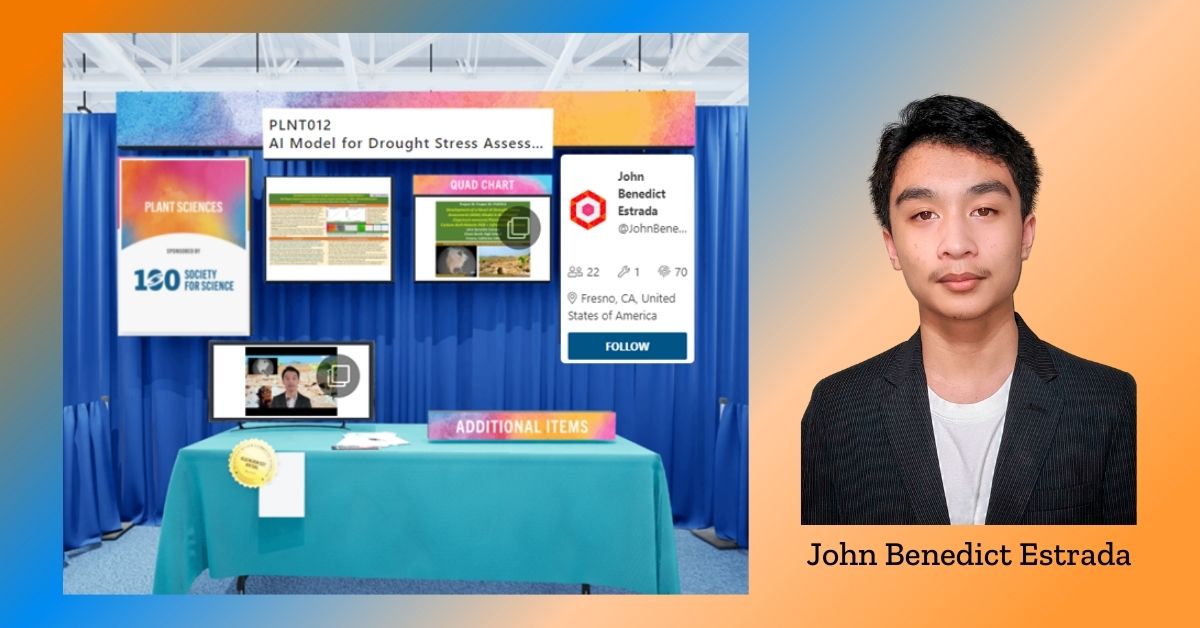John Benedict Estrada, a sophomore from Fresno, California, USA won at the Regeneron International Science and Engineering Fair (ISEF) — the world’s largest international high school science competition — for developing a novel computer program to accurately predict drought stress in plants using images from a custom-built robotic camera and advanced Artificial Intelligence (AI) technology. Estrada has been awarded the Gordon E. Moore $50,000 Award for Positive Outcomes for Future Generations at the science competition.
Called the AI Drought Assessment or AIDA model, the program can essentially detect drought early on to give farmers extra time to prepare. The system also exploits the “stay green” phenomenon in certain plants which leads to an increased green and decreased red and blue light reflectance, as part of a plant’s early response and adaptation to drought. For example, pepper plants have “stay green” genes that allow their leaves to retain their green color even when their photosynthetic activity declines, due to interference in the chlorophyll degradation pathway. This phenomenon, along with decreasing leaf hydration, causing increased chlorophyll concentration during drought stress, leads to an increasing green reflectance, and decreasing red and blue reflectance, which are detected by the RGB camera. This early sign of drought stress is difficult to see or evaluate if farmers were to rely on just calculated CWSI values.
“This novel artificial intelligence program can quickly and more accurately predict drought stress in bell pepper plants compared to the Crop Water Stress Index (CWSI) using variables that are all direct stress indicators, rather than atmospheric variables that are only indirect indicators of drought stress in plants. In contrast to the CWSI, which is an old method of detecting drought stress, my AIDA model uses RGB light reflectance values, leaf canopy temperatures, and soil moisture data. As I have found from my 7th & 8th-grade science fair projects, vegetation indices, such as NDVI, RNDVI, and GNDVI, are calculated based on RGB light reflectance values, which are used to estimate photosynthetic activity and determine water and nitrogen uptake into the plant canopy. The plant canopy temperature indicates radiated heat from plant leaves and is an indicator of the plant’s transpiration rate. Furthermore, soil moisture could tell us if the soil has enough water available for the plant’s use,” according to the 16-year old teen scientist.
Using John Benedict’s AIDA model, prediction of drought stress in plants will not only help farmers conserve precious water resources but also allow them to maximize their yield.
This new AIDA model was programmed on a Raspberry Pi 3B using Python 3.7 utilizing the TensorFlow 2.0 AI platform by Google, and the Keras API. A “sequential model” with three (03) neural net layers was constructed using Adam as the optimizer and mean squared error as the loss function. The metrics used in the model were mean squared error and mean absolute error. An early stopping function was also incorporated to prevent overfitting.
Born in Michigan, USA, both of John Benedict’s parents are Filipino immigrants who did their graduate studies at the Michigan State University. At present, his mom is a plant breeder while his dad is a medical oncologist and hematologist.
“I was born in Michigan, USA, but I spent 2 years of my life in the Philippines. I was 3 years old, and my sister was a year old when my mom brought us back to the Philippines in 2008. We stayed there for 2 years while she worked at the International Rice Research Institute, before moving back to Fresno, California in 2010,” added Estrada.
John Benedict’s advice to other students who want to excel in science or any field of their choice: “Keep on persevering and do not be scared of sailing into unexplored waters. Think original, and out of the box. You never know, you might discover a solution to a problem in your community that has never been thought of. Also, work on your communication skills. The only time that you can say that your project is a success, is when you are able to communicate your results effectively to the scientific community and the public.”
His US$50,000 winnings come in the form of a scholarship grant that may be used for his college or graduate education at a higher institute that he wishes to attend.


